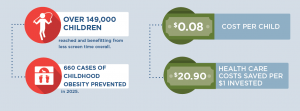The information in this brief is intended for educational use only.
This brief provides a summary of a CHOICES Learning Collaborative Partnership simulation model of incorporating opportunity for screen time counseling in Oklahoma’s WIC Program by training WIC staff to assess and offer motivational interviewing counseling to WIC participants on strategies for modifying screen time behaviors.
The Issue
Over the past three decades, more people have developed obesity.1 Now labeled an epidemic, health care costs for treating obesity-related health conditions like heart disease and diabetes were $147 billion in 2008.2 While multiple strategies are needed to reverse the epidemic, emerging prevention strategies directed at children show great promise.3 A large body of evidence shows limiting screen time like non-educational television helps kids grow up at a healthy weight. The more TV children watch, the more they overeat or eat unhealthy foods and drinks that are advertised, leading to excess weight gain. The American Academy of Pediatrics recommends children ages 2-54 get a maximum of 1 hour screen media daily, half what they currently get5; the Guide to Preventive Services recommends implementing strategies to reduce screen time to prevent childhood obesity.6
WIC provides food benefits to low-income children and is the only federal nutrition assistance program required by law to provide nutrition education to participants. In Oklahoma, 26.5% of 2-4 year olds participate in WIC; nearly 15% of these children have obesity.7 The WIC Program offers an opportunity to provide education and support for families to adopt healther screen time habits.
About the Policy and Training to Help Families Participating in WIC Reduce Screen Time
The intervention incorporates screen time counseling into required WIC certification visits through the inclusion of relevant assessment items within the existing screening assessment tools regularly used by WIC clinical staff. Oklahoma’s WIC office participates in VENA, which establishes standards for the assessment process used to determine WIC eligibility and to personalize nutrition education, referrals and food package tailoring. The intervention modeled includes training for WIC staff who provide motivational interviewing and counsel to WIC participants. The training, offered by the state Department of Health WIC Services office, would include strategies for providing participants with guidance for modifying screen time behaviors.
Comparing Costs and Outcomes
CHOICES cost-effectiveness analysis compared the costs and outcomes of integrating screen time questions and counseling into the standard OK WIC practices over 10 years with costs and outcomes associated with not implementing this initiative. The approach assumes all WIC clinics in Oklahoma would integrate screen time questions into VENA and provide counseling to those families who select it as a target.
| Implementing screen time counseling in WIC is an investment in the future. By the end of 2025:  |
Conclusions and Implications
Every child deserves a healthy start in life. This includes ensuring all kids have opportunities to be healthy. A state-level initiative to provide screen time counseling to families participating in WIC could prevent 660 cases of childhood obesity in Oklahoma in 2025 and ensure healthy screen time habits for over 149,000 children.
For every $1 spent on implementing this screen time strategy, $20.90 would be saved in health care costs.The results reinforce the importance of investing in prevention efforts, relative to other treatment interventions, to reduce the prevalence of obesity. Shortchanging prevention efforts can lead to costlier and complicated treatment options in the future, whereas introducing small changes to young children can help them develop healthy habits for life.
Evidence is growing about how to help children achieve a healthy weight. Programs to reduce screen time are laying the foundation for a healthier future by helping families create environments that nurture healthy habits. Leaders at the federal, state, and local level should use the best available evidence to determine which evidence-based programs and policies hold the most promise to help children grow up at a healthy weight.
References
- Flegal KM, Kruszon-Moran D, Carroll MD, Fryar CD, Ogden CL. Trends in Obesity Among Adults in the United States, 2005 to 2014. JAMA. 2016 Jun 7;315(21):2284-91.
- Finkelstein EA, Trogdon JG, Cohen JW, Dietz W. Annual Medical Spending Attributable To Obesity: Payer-And Service-Specific Estimates. Health Affairs. 2009;28(5).
- Gortmaker SL, Wang YC, Long MW, Giles CM, Ward ZJ, Barrett JL, Kenney EL, Sonneville KR, Afzal AS, Resch SC, Cradock AL. Three interventions that reduce childhood obesity are projected to save more than they cost to implement. Health Aff (Millwood). 2015 Nov;34(11):1932-9.
- American Academy of Pediatrics. (2011). Media Use by Children Younger Than 2 Years. Pediatrics, 128(5), 1040-1045. http://pediatrics.aappublications.org/content/128/5/1040
- Common Sense Media. (2013). Zero to Eight: Children’s Media Use in America 2013. www.commonsensemedia.org/research/zero-to-eight-childrens-media-use-in-america-2013
- Buchanan, L. R. et al. (2016). Reducing Recreational Sedentary Screen Time: A Community Guide Systematic Review. Am J Prev Med, 50(3), 402-415. https://www.thecommunityguide.org/sites/default/files/publications/obesity-AJPM-evrev-behavioral_0.pdf
- Communication with Oklahoma State Department of Health: WIC Service. (2017).
Suggested Citation:Bryce T, Kenney EL, Giles CM, Flax CF, Gortmaker SL, Ward ZJ, Cradock AL. Oklahoma: Incorporating Screen Time into the Special Supplemental Nutrition Program for Women, Infants and Children (WIC) Modified Value, Enhanced, Nutrition Assessment (VENA) [Issue Brief]. Oklahoma State Department of Health, Oklahoma City, OK, and the CHOICES Learning Collaborative Partnership at the Harvard T.H. Chan School of Public Health, Boston, MA; August, 2017. |
The design for this brief and its graphics were developed by Molly Garrone, MA and partners at Burness.
This issue brief was developed by the Oklahoma State Department of Health through participation in the Childhood Obesity Intervention Cost-Effectiveness Study (CHOICES) Learning Collaborative Partnership at the Harvard T.H. Chan School of Public Health. This brief is intended for educational use only. Funded by The JPB Foundation. Results are those of the authors and not the funders.
